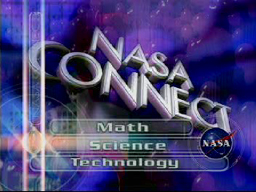National Aeronautics and Space Administration
Goddard Space Flight Center

Sun-Earth Day 2010: Magnetic Storms
NASA CONNECT™
- Eclipse in a Different Light
- In Path of Totality: Measuring Angular Size and Distance, students learn about the natural phenomena that create a total eclipse. Students also explore the history, mythology, science, and math that relate to these amazing events. NASA scientists and engineers introduce a satellite where scientists make artificial eclipses in order to learn more about the Sun's corona. Using hands-on lessons, web-based activities and simple tools, students will measure the angular size and predict the angular distance of objects in the sky.
- Ancient Observatories: Timeless Knowledge
- In Ancient Observatories: Timeless Knowledge, students will learn how cultures from ancient times to the present have used the Sun and other objects in the sky to mark the passage of time. They will see how archaeoastronomers use ancient observatories to predict seasons and special events. Using simple tools of geometry and the angle bisector method, students will measure the movement of the Sun and find solar noon for their location. By conducting inquiry-based and web activities, students will make connections between NASA research and the mathematics, science, and technology they learn in their classrooms.
- Venus Transit
- In the Venus Transit, students will learn about the importance of using scale models to represent the size and distance of objects in the solar system and beyond. They will be introduced to the astronomical unit (AU), the baseline distance from the Earth to the Sun, which astronomers use to determine the relative distances from the Earth to other planets, stars, asteroids, and objects in space. They will also discover fascinating facts about the Venus Transit, a celestial and historical event, which helped astronomers determine the scale of the solar system. By conducting inquiry-based and web activities, students will make connections between NASA research and the mathematics, science, and technology they learn in their classrooms.
- Dancing in the Night Sky
- In Dancing in the Night Sky, students will learn about the Aurora Borealis or Northern Lights. They will learn the many legends and myths that have revolved around the aurora throughout the history of mankind. Students will also discover how NASA scientists and engineers use satellite technology to measure and analyze aurora data. They will see how Norwegian scientists apply the concepts of data analysis and measurement to study the Northern Lights by using ground-based instruments and sounding rockets. By conducting hands-on and web activities, students will make connections between NASA research and the mathematics, science, and technology they learn in their classrooms.
- Having a Solar Blast
NASA engineers and researchers use data analysis and measurement to predict solar storms, anticipate how they will affect the Earth, and improve our understanding of the Sun-Earth system.
Mathematics: data analysis, measurement
Science: science as inquiry, unifying concepts and processes, physical science, Earth and space science, science and technology, science in personal and social perspectives
NASA Research: Solar Heliospheric Observatory (SOHO), Imager for Magnetopause-to-Aurora Global Exploration (IMAGE)
NASA TV
Be sure to keep you eye on NASA TV for the latest updates and information on programs featuring Sun-Earth Connection science! You will also find a multitude of resources including the following:
- Daily NASA Television Programming Schedule: This is the standard programming schedule for NASA Television, updated weekly. Programming may be preempted at any time for coverage of live events. Click on the "Live Events" link below for updates.
- Live Events, News and Special Event Programs: This schedule lists press conferences, mission coverage, employee events and Agency special event coverage and is updated frequently.
- NASA Television Video file: This advisory to the news media describes the most current audio and video resource material of Agency events. The advisory is updated frequently. The video file airs at 12 p.m. (EST or EDT), with replays at 3 p.m., 6 p.m., 10 p.m., 12 a.m., 6 a.m. and 10 a.m.
- Education File: This schedule of programming is specifically designed for students and teachers. The Educational File airs weekdays from 8 a.m. to 10 a.m., 4 p.m. to 6 p.m., and 8 p.m. to 10 p.m. On weekends, the Education File airs from 8 a.m. to 12 p.m., 4 p.m. to 6 p.m., and 8 p.m. to 10 p.m.(EDT or EST) Education file may be preempted by other events.
NASA Fact
The geographic location of Earth's North Magnetic Pole is currently moving nearly due-North at a speed of 100 meters per day.





